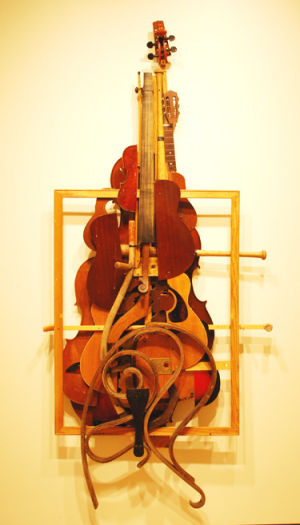Exhibition at the Mulvane
October 21, 2009
There is a building on campus where you can find the print of a biker bar, cherubs wrestling, Japanese sword hilts and a cello made out of machine guns. Those and many other items of wonder and interest are yours to enjoy at Washburn’s very own Mulvane Art Museum. Perhaps one of our finest and under appreciated resources, it waits for your discovery at 1700 SW College Ave., between White Concert Hall and the Memorial Union. Look for the stately building with the large stone columns that were sturdy enough to survive the 1966 tornado.
This homecoming week, Cindi Morrison, director of the Mulvane Art Museum, invites everyone, returning alumni, current students and local residents to visit the museum. Actually everyone is welcome, free of charge, any time of year. The museum is open Tuesday 10 a.m. to 7 p.m., Wednesday through Friday 10 a.m. to 5 p.m., Saturday and Sunday 1 p.m. to 4 p.m.
One exhibit currently on display is Ken Butler’s “Hybrid Visions.” Though his work could be considered green because he recycles discarded objects, what he does has absolutely no resemblance to a multi-fuel car. With a unique eye and vivid imagination, Butler creates hybrid musical instruments out of unlikely materials. They are puzzling and a treat to the eye. If the bent arm violin doesn’t make you pause and ponder, maybe the bike seat banjo or the wood strip grand piano will. These amazing works stand on their own, but the real kicker is that they are working instruments. Ken Butler actually came on campus and played these hybrid instruments at Washburn’s recent Family Days. It is a large and diverse collection split between both floors of the museum. This exhibit will be on display until Jan. 24.
Turn right past the front door and you will see Justin Marable’s “Ageless Wonder” exhibit. It’s a wonderful collection of serigraph and mono-prints that combine scenes as familiar as the Jayhawk Tower’s neon Jayhawk against a surreal sunset, and a bucolic farm landscape with a classic Japanese rising-sun-sky. One might think such different styles would clash in the same frame, but Marable combines the familiar with the unexpected so well that they would be lost without one another. These prints will be on display through Oct. 25.
Upstairs you can see “A Few of Our Favorite Things,” selections from the Museum’s own Whitcomb and Wilson collections. Robert F. W. Whitcomb, a 1915 graduate of Washburn, worked many years in Japan and collected Japanese prints, Tsubas (sword hilts) and Yatates (portable pen and ink containers). The prints are in the classic Japanese style: fine delicate lines and subdued colors depicting beautiful maidens and every day life. They date from 1730 to 1880. The Tsubas, meant to balance the sword and protect the hands, are individually made and recall the glory days of the Bushido, the Japanese warrior code. The portable pen and ink cases reflect how Japanese culture elevated the fabrication of common objects to an art form: simple, useful, beautiful. Whitcomb donated his collection in 1968 and 1970 in honor of Frances Davis Whittemore, Director of the Washburn Art Museum from 1912 to 1929.
Barbara Wilson’s collection of Meissen figurines provide and interesting and whimsical contrast to the other displays. The hand painted, hard-paste porcelain pieces are intricate in detail and vary from wrestling cherubs to the infant Bacchus, god of wine and over indulging. Wilson donated these delightful figurines in 2007. The “Favorite Things” collection will be shown until Jan. 17.
While you are at the Mulvane Art Museum, be sure to check out the family and community activities. There are special events, an art lab and art classes. Oct. 31, 1 p.m. to 4 p.m. you can create a tissue papel picado to celebrate the Day of the Dead.
The museum offers a lot to enjoy without a fee and can do so thanks to the help of donations and volunteers. You can get involved by contacting Jan Bychinski at 670-2427.



